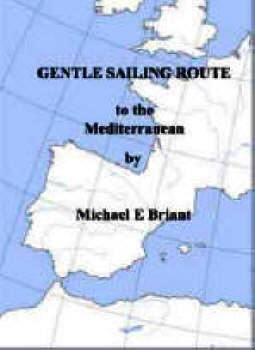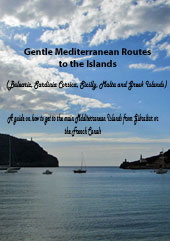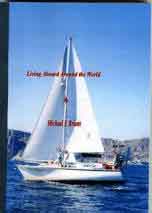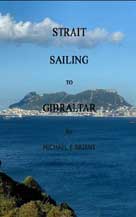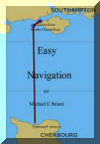|
Routes Between the English Channel and the Mediterranean This is the excellent company I use:
|
|
SN3 Calais or Le Havre |
|
SN3 The CANALS ROUTE from Calais or Le Havre to the Mediterranean. This is the 'Classic' route - in at Le Havre (excellent crane facilities) enjoy Paris - motoring through the 'city' in a boat is un-missable - then the Canal sur Briare, Canal Lateral a la Loir, Canal du Centre into the Soane then the Rhone.... This route is a little longer but has fewer locks so is quicker - I have done it in two weeks coast to coast but you should take much longer as it is lovely.
An alternative is the scenic route via St Valery or Calais BEST TIME - almost any time of year is possible but IN WINTER the canals can freeze making progress impossible. There are few marinas or places with shore power so you need your own heating system in the boat. The river sections of the route can be subject to flooding in late summer or winter. Having crossed the English Channel to Le Havre or Calais, which are the closest for most people, you need to get your mast down and surround your hull with motor car tyres. As many as possible - normally there are a stack of these beside the cranes left by the boats going the other way. The law requires 2 lines per tyre - I wrapped my tyres in rubbish bags, secured by lots of sticky tape and just kept adding bags as they wore out - black car tyres on your hull leave a dreadful mess. before arrival under the crane you normally disconnect all the electrics yourself, loosen shrouds and stays and motor up underneath the crane - I have found the operators to be experts doing hundreds of masts a year and am guided by them. It may be worth making a couple X mast supports for the mast on deck before you leave the UK. A hh vhf or the main set connected to a spare antenna is useful but not essential. Of the 2 routes, the Le Havre option is probably the nicer as it is much shorter and goes through Paris . How ever well you know the city from the water it is a wonderful experience. NOTES ON THE CANALS Draft = 1.8 metres - 5ft 9inchs. Beam = 5 metres - 16ft 4inches. Height = 3.5 metres - 11ft 4 inches. (The above are for the main canals and rivers to the Mediterranean - there is a tunnel in on the canal du Bourgogne with a height of 3.1 metres and the canal du Nivernais has a max draft of 1.2 metres but there is no reason to use these unless exploring...) I have only listed the direct routes from the channel ports to the Med. There are many more canal cruising routes if you want to do that. Le Havre or Rouen Crane and Mast Transport If you decide to have the mast shipped down to the med by lorry For mast tranpot by road * around 1100 MAR@LAGO bvba OSSEBILKSTRAAT 19 - BE-8211 AARTRIJKE GSM FRANKY : +32 473 86 22 85 / +33 620 29 13 92 EMAIL : info@maradlago.be WEBSITE ON WWW.MARADLAGO.BE Demasting and masting in Rouen Activitι plaisance Lamanage Rouen Tιl : 02.32.10.26.57 Fax : 02.35.70.52.37 activiteplaisance@lamanage-rouen.fr Activite Plaisance is a proper boat yard with travel lift and mast crane. You can arrange for MAR@LAGO to collect or deliver from this yard ex Port Napoleon Most of the cost is in the transport. Be prepared for a long days work on your own boat and helping others. If you decide to carry the mast on deck The crane belonging to the Le Havre Capitainerie costs around 100 for half an hour which is all you should need if you arrive prepared at the crane. Alternatively go up the Seine to Rouen and dismast at Activite Plaisance. You need HW and they should be pre-booked. The direct route from Le Havre is as follow - De-mast in the Marina then motor back out into the estuary find the Chenal du Rouen and head up the Seine towards Paris via Rouen. - (Navicarte #1 has proper sea charts for the estuary and all the way to Paris.) Rouen. We used the Harbour Authority in Rouen. You go into St Gervais harbour to dismast. The harbour office is up river on the left bank near the new bridge that's under construction. They charged us 150 for the crane. You must pay first and then they get a driver for the crane. They are very helpful and even sent a car for me to bring me to the office from the harbour. Its about a kilometre away. There is a visitors pontoon opposite the cranes in the harbour (no facilities). The marina in Rouen is good. There are shops just over the bridge and there's a good chandlery beside it. You need to treat the Seine with respect - it is a powerful fast flowing river and you need to work the tides. You can of course moor in the centre of Paris in the Paris-Arsenal Marina. From Paris to St Mammes - the first part of the upper reaches of the Seine you need Navicarte #2 - beautiful river much like the upper reaches of the Thames but wider... only 7 locks in in 87 Km. and at St Mammes you hang a right into the Canaux du Loing and the canaux de Briare. This section 103Km and has 50 locks! Next is the Canal Lateral a la Loire from Briare to Digon - much easier with only 37 locks in 196Km... At Dignon you join the Canal du Centre which goes to Chalon (big yacht harbour H20) some 112km later and 61 locks. this is about half way. Here you join the river Soane and the trip becomes different but no less delightful. You turn right again into the Soane shortly after Chalon and proceed down this beautiful river for another 223 Kms via Macon to Lyon. You can park up in the middle of town.......... From Lyon you enter the mighty river Rhone - 312Km and 12 locks.. this river has been tamed by its locks and generating barriers not to mention the huge nuclear power facilities. Its advertised rate is 4knots so you go down stream at a good rate. The locks are vast and you moor your boat to a single floating bollard and hold very tight - if you are more or less alone in the lock the turbulence can be signifigent. About 3 days later, having may be stopped at Arles and Avignon, both a little off the route, you arrive in Port St Louis and lock through into the basin and the marina or in Sete and go to the yacht club to get your mast re-stepped and to dump all the tyres for the next boat to use.. out into the Mediterranean... The Scenic Route = My log and some pictures of a recent transit. You need the following Navicarte or similar publications #1 = La Seine aval - le Havre to Paris #2 = La Seine amont - Paris to St Mammes - short section and if you have another general guide you could possibly get away with that? #6= Canaux du Centre (includes the canal du Brise, Lateral and Loir as well - its really just one route) #10= La Saone #16 = Le Rhone which takes you to both Port St Louis and to Sete.
For information about closures - repairs and maintenance work visit http://www.vnf.fr which is the River and Canals authority official web site. It is in English and French. Some of the English pages do not always work or have not been updated so try and struggle with the French version if that's the case. NAVIGATION FEESLicence (Vignette) Fees 2022Navigation fees are simply based on boat length. The vignette certificate should be displayed at the front of the boat, on the starboard side.
HOW LONG WILL IT TAKE? well that's up to you? A shame to rush it but one time I needed to get a boat back quickly to the UK, very late in the season. I did Sete to Le Havre in 2 weeks. Moved every day from 08.00 to sunset (you are not allowed to move at night) and only had one day off and was knackered - that was effectively single handing as the 'crew' had no boating experience and could not help much... So that's it - if you are in a real hurry a couple of weeks or all summer - know which I prefer! CALAIS & ST VALERY SUR SOMME OPTIONS via Calais Enter the main harbour and get the local crane to take down your mast. Then go through the Ecluse (lock) Carnot and then the Ecluse Batellerie and hang a left into the Canal de Calais (mooring pontoon there) You then pass through 5 automatic lifting - swing bridges and 1 lock operated by rods (VHF 10 if problems) A trip of 30 Km to the river Aa near Watten. From there it is18Km down the Canal de la Colme to St Omer. From here you join the Canal de Neufosse to Aire. (18Km and 2 locks). Near Aire you join the Canal d'Aire for 41Km and 1 lock to Beauvin where you join the Canal de la Deule for 21Km until you get to Douai where you join the Canal de la Sensee for about 24Km and 1 lock. When you get to Etrum you can join the River Escauit for 11Km but no less than 5 locks until you get to Camgrai with its marina and good shopping. The next canal is the Canal de St Quentin which runs from Cambrai to Chauny through 35 locks for some 92Km. There are two tunnels one of just over a 1Km and the other 5.6Km - you have to be towed though this one and 'tows' are assembled twice a day in each direction and you have to pay a fee - it takes at least a couple of hours. When you get to Chauny you take the Canal de l'Oise a l'Aisne for 48Km, 13 locks and 1 tunnel of 2.5Km. Quite a lot of commercial traffic which gets priority. This canal gets you to the Marne - which then leads into the Canal de la Marne a la Soane for some 225 Km and 114 locks (a lock every couple of hours!) Slows you down a lot but improves your boat handling skills! When you get to the Soane you join this river and the boats that came through Paris. - There are lots of variations on the above route depending on the speed you want to progress v enjoyable lazy cruising avoiding as many locks as possible. Into the Soane and proceed down this beautiful river for another 250 Km via Macon to Lyon. You can park up in the middle of town.......... From Lyon you enter the mighty river Rhone - 312Km and 12 locks.. this river has been tamed by its locks and generating barriers not to mention the huge nuclear power facilities. Its advertised rate is 4knots so you go down stream at a good rate. The locks are vast and you moor your boat to a single floating bollard and hold very tight - if you are more or less alone in the lock the turbulence can be significant. About 3 days later, having may be stopped at Arles and Avignon, both a little off the route, you arrive in Port St Louis and lock through into the basin and the marina or in Sete and go to the yacht club to get your mast re-stepped and to dump all the tyres for the next boat to use.. out into the Mediterranean... The Navicartes you will need for this route variation are: #14 = Nord Pas de Calais #24 = Picardie #8 Champagne-Ardenne #10 La Soane #16 la Rhone. Via ST VALERY SUR SOMME St Valery is situated half way between Calais and Le Havre and is another possible way of getting into/out of the European Canal System. Unlike Le Havre and Calais which can be entered at any state of the tide St Valery has extensive shoals and at LW neaps will dry - you need the appropriate chart or pilot and a rising tide - having said that it is well buoyed. There is a good marina at St Valery to de-mast. The sea locks opens roughly 1 hour either side of HW and lets you into the Canal de la Somme (lots of WW1 connections and memorabilia) You pass though Abbeville and Amiens on your way to the Canal Du Nord - turn right and head south for Compiegne. There is then a choice of heading SW to go through Paris and join the classic route south. Alternatively head East then South towards the Canal de la Marne a la Soane. There are many variations on this basic route and you need to get the canal charts and books to make your own decision The Extra Navicarts you need are: #24 Picardie - gets you from St Valery to Paris from where you would want :- #2 = La Seine amont - Paris to St Mammes #6= Canaux du Centre (includes the canal du Brise, Lateral and Loir as well - its really just one route) #10= La Saone #16 = Le Rhone which takes you to both Port St Louis and to Sete. Or if you avoid Paris and take possibly a nicer and shorter route #24 Picardie - gets you from St Valery #8 Champagne-Ardenne for the Canal de la Marne et Soane. #10 La Soane #16 Le Rhone At some point you will have to buy a license for the time spent in the river canal system - fairly inexpensive VNF has the details and charges - Check on the official web site http://www.vnf.fr for info on closures works and all information - the French site works better than the English.
Some canal tips 1. Take off your masthead light, wind vane and vhf antenna - put a bucket over the top of the mast to protect it - they always seem to get bashed. 2. You will need 2 lines to each tyre fender (by law) As you will need as many as possible buy some cheap nylon rope to fix the 'fenders' as you will probably not have enough short lengths in the locker. 3. Keep a knife available in the cockpit just in case one of the mooring lines gets snagged and hangs the boat up as the water goes down in the lock. 4. If you are short handed (only 2) and you have a long enough line - fix a block on the bows and lead the fwd warp through the block and back along the deck to the cockpit - that way who ever is in the cockpit can pull in or let out the lines in the lock if the other one gets stuck on the lock side and is unable to get back on board. 5. You will need a hammer or preferably a mallet to hammer metal spikes into the bank to moor to at night. Frequently keel yachts can only get their bows close to the shore as the rivers/canals frequently shallow at the sides. 6. It may be worth considering having the mast taken by lorry to your destination - Certainly makes the trip easier in terms of moving around the boat. 7. At some point you will have to buy a license for the time spent in the river canal system - fairly inexpensive and check on the official web site http://www.vnf.fr for info. The license is based on the time you intend staying in the waterway system - by day/week/month/year. 8. Under European (and of course French) law anyone operating a boat on the European canal system is required to have a 'boat driving license' as issued by their own country of origin. You can travel in any European river or canal with only the license issued by your own authority. Catch 22 is that the British authorities do not require you to have one! Under the new French 1991 law you need a Certificate of Competence which is issued by the RYA. You may also pass the French test - cat C for boats less than 15m and slower than 20Km/h. Many sea boats do the transit without the certificate. (If you rent a hire boat in France as a Brit you are not required to have a certificate.)
SN1 = north to south - direct route by sea SN2 = north to south via Canal du Midi SN3 = north to south via Le Havre - Paris - or Calais or St Valery SN4 = south to north via Atlantic coast SN5 = south to north via Azores SN6 = south to north via Canal du Midi SN7 = south to north via canals to Paris and Le Havre or Calais Lorry option = a list of web sites of British and French haulage companies who specalise in boat transport. Canal du Midi = My log and some pictures of a recent transit. (SN7) The Scenic Route = My log and some pictures of a recent transit. (SN6) Parking Places in the Rhone = A list of the relatively few possibilities to overnight in the Rhone. VNF = Voies Navigables de France - details of license fees and canal offices - official paper http://www.sailtrain.co.uk/cevni/images/cevni1.htm This site has a series of tests for the written part of the CEVNI certificate find out if you know the rules! Probably the best site for learning boating things on the net!
|
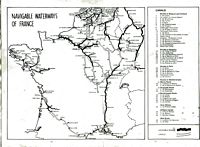 Click
here for canals chart
Click
here for canals chart
